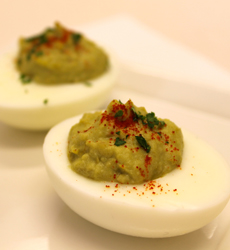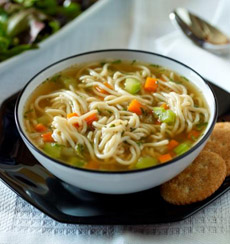|
For all the deviled egg fans out there: Here‘s a springtime recipe for Sweet Pea Deviled Eggs from Del Monte. You can use cooked fresh spring peas in season (now!), or can use canned peas year-round. This recipe also works for St. Patrick’s Day and other green-theme occasions.
Substituting peas and avocado for half of the egg yolks reduces the cholesterol load.
Prep Time: 10 minutes
Cook Time: 10 minutes
Makes: 24 stuffed egg halves
RECIPE: Sweet Pea Deviled Eggs
Ingredients
12 eggs, hard-cooked
1 cup cooked spring peas or 1 can (8.5 oz.) Del Monte Sweet Peas-No Salt Added, drained
1 ripe avocado, peeled and pitted
1/4 cup light mayonnaise
1-1/2 teaspoons sugar (optional)
1 tablespoons plus 1 teaspoon cider vinegar
2 teaspoons prepared mustard
Salt and pepper, to taste
Chopped fresh basil, chives or parsley
Optional: sweet paprika
|
|

These deviled eggs have reduced cholesterol: Only half of the yolks are used. Photo courtesy Del Monte.
|
|
Preparation
1. COOK eggs: Place in a large saucepan, completely covered in cold water. Bring to a boil over high heat, reduce heat and simmer 10 minutes. Remove from heat, run under cold water briefly and peel. Peeling under cold running water helps to remove the shell more easily and helps to cool the eggs for handling. Cut in half lengthwise. Remove the yolks; set aside 6 of the 12 yolks for for another purpose (see below).
2. PLACE 6 egg yolks in a blender or food processor with the peas, avocado, mayonnaise, sugar, vinegar, mustard and salt and black pepper. Purée until smooth.
3. SPOON equal amounts of the purée into each of the egg white halves. Garnish with parsley and/or paprika.
|

If you have extra yolks, we know what to do
with them. Photo courtesy American Egg
Board. |
|
USES FOR COOKED EGG YOLKS
If you’ve got extra egg yolks:
Mix into chicken salad, egg salad, potato salad or tuna salad.
Crumble, grate or sieve over green salad, cooked vegetables, rice and grains.
Mash with mayonnaise, relish, salt and pepper and serve on toast as a snack or first course, with crackers as a snack, or stuffed into celery or endive leaves.
Pennsylvania Dressing for a green salad (recipe follows).
We found this recipe for Pennsylvania Dressing, which was served in the dining cars of the Pennsylvania Railroad atop a salad of iceberg lettuce, tomato wedges, sliced cucumber, scallions, radishes and celery:
|
|
PENNSYLVANIA DRESSING RECIPE
Ingredients
2 hard-cooked egg yolks
Tarragon vinegar
1 teaspoon paprika
1 teaspoon celery salt
1 heaping teaspoon powdered sugar (omit if you don’t like sweetness in your dressing)
1 green pepper, chopped medium fine
6 chives or small young onions, chopped very fine
1 sprig parsley, chopped fine
Juice of 1/2 lemon, strained
1/2 cup olive oil
1 cup mayonnaise
Preparation
1. MASH egg yolks with enough tarragon vinegar to make a smooth paste.
2. ADD each ingredient in the order listed, mixing well before adding the next. Beat with a whisk until blended thoroughly, about 1 minute.
3. POUR into a glass jar and cover tightly. Chill at least 1 hour before serving. Makes 1 pint.
FOOD TRIVIA: WHY THE EGGS ARE HARD COOKED, NOT HARD BOILED
It‘s a technicality: While the cooking water is brought to a boil, the eggs are actually simmered until cooked, not boiled.
|
|








